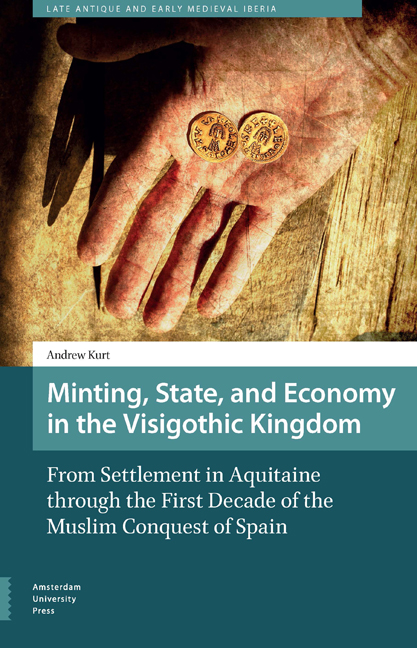 Minting, State, and Economy in the Visigothic Kingdom
Minting, State, and Economy in the Visigothic Kingdom Book contents
- Frontmatter
- Contents
- List of figures
- Acknowledgments
- Introduction
- 1 Pre-Regal Visigothic Coinage
- 2 The King’s Coinage: The Beginning and Development of theRegal Coinage (c. 573-c. 720) 81 A The Transition to a Regal
- 3 The Activities of the Mints from c. 573- c. 720
- 4 Why Were Gold Coins Struck in the Visigothic Kingdom?
- 5 The Royal Control of Visigothic Minting
- 6 Coinage in Spain in the Aftermath of the Islamic Conquest
- 7 Visigothic Currency in the Early Medieval Economy
- Conclusion
- Appendix I
- Appendix II
- Bibliography
- About the Author
- Index
- Frontmatter
- Contents
- List of figures
- Acknowledgments
- Introduction
- 1 Pre-Regal Visigothic Coinage
- 2 The King’s Coinage: The Beginning and Development of theRegal Coinage (c. 573-c. 720) 81 A The Transition to a Regal
- 3 The Activities of the Mints from c. 573- c. 720
- 4 Why Were Gold Coins Struck in the Visigothic Kingdom?
- 5 The Royal Control of Visigothic Minting
- 6 Coinage in Spain in the Aftermath of the Islamic Conquest
- 7 Visigothic Currency in the Early Medieval Economy
- Conclusion
- Appendix I
- Appendix II
- Bibliography
- About the Author
- Index
Summary
It is hoped that the reader of these chapters will appreciate that it is imperative to connect the historiography of the Visigothic kingdom's lengthy rule with its coinage. Failing to do so will leave a very incomplete picture. This book began with consideration of the problem of the perspective of continuity or discontinuity of the Visigothic monetary system set in the framework of the very late ancient Mediterranean world. Treatment of the many facets involved in the currency point to an abundance of both traits. Minting as well as use of currency, of different denominations as has been explained in detail, underwent a process of frequent change. No less than the Roman empire from which it took inspiration, the Visigothic kingdom cannot be seen as static across its three-hundred-year existence. Study of the vicissitudes of the currency afford a deeper understanding of structures and life in the kingdom.
As seen in taxation, agricultural practices, law, administration, and other matters there was more continuity than fracture, but adaptations occurred that eventually bear less resemblance to the Roman foundation. In the regal gold currency, the early adaptation is evident in the royal image and inscription, reduced real fineness and weight standards, the plethora of mints and their regional-local association with tax payments and in numerous instances with apparent military expenditures. Later adaptation is visible in the high level of adulteration of the tremisses and the further stylistic distinctions of the coins. Yet, in the mid-seventh century reforms, and even in the imagery employed in the final decades of Visigothic Iberia, the imperial model was of key importance.
The establishment of a state derived much from Roman foundations, but government and culture took on their own character, and these combined forces were at work in shaping the Visigothic solidus and tremissis and the system that produced them. The first chapter of this book reviewed the earliest Visigothic coinage in Roman Gaul. From the perspective of the later chapters one can see a basic continuity in the development of the minting system as the Visigoths began to center their kingdom on the Iberian peninsula. The currency continued to be based essentially on gold even when the striking of solidi ceased and bronze or copper coinage appeared in mostly southern locales.
- Type
- Chapter
- Information
- Minting, State, and Economy in the Visigothic KingdomFrom Settlement in Aquitaine through the First Decade of the Muslim Conquest of Spain, pp. 283 - 290Publisher: Amsterdam University PressPrint publication year: 2020


